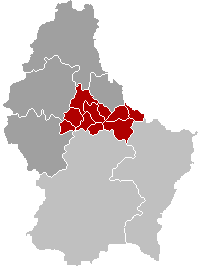Diekirch
| Diekirch Dikrech | ||
|---|---|---|
| Commune | ||
 | ||
| ||
|
Map of Luxembourg with Diekirch highlighted in orange, the district in dark grey, and the canton in dark red | ||
| Country |
| |
| District | Diekirch | |
| Canton | Diekirch | |
| Government | ||
| • Mayor | Claude Haagen | |
| Area | ||
| • Total | 12.42 km2 (4.80 sq mi) | |
| Area rank | 90 of 105 | |
| Highest elevation | 396 m (1,299 ft) | |
| • Rank | 54th of 105 | |
| Lowest elevation | 187 m (614 ft) | |
| • Rank | 21st of 105 | |
| Population (2014) | ||
| • Total | 6,649 | |
| • Rank | 18th of 105 | |
| • Density | 540/km2 (1,400/sq mi) | |
| • Density rank | 14th of 105 | |
| Time zone | CET (UTC+1) | |
| • Summer (DST) | CEST (UTC+2) | |
| LAU 2 | LU00002004 | |
| Website | diekirch.lu | |
Diekirch (Luxembourgish: Dikrech; from Diet-Kirch, i.e. "people's church") is a commune with city status in north-eastern Luxembourg, capital city of the canton Diekirch and the district of Diekirch. The city is situated on the banks of the Sauer river. The name comes from DIDOEKIRCH (Dido's Temple). This is a Dido of the Germanic pantheon of Gods, not the Greek or Roman. Originally, there was a Germanic/Celtic temple here. The area is full of Germanic/Celtic remains and place names.
The city's heraldic shield, showing a crowned lion on a castle, was granted in1988. It is based on the city's 14th century seal and arms.[1]
As of 2001, the town of Diekirch, which lies in the south of the commune, has a population of 6,068.
Diekirch was the first city in Luxembourg to have a pedestrian zone, in 1977.
There is a brewery with the same name. There are 3 secondary schools in Diekirch: Lycée classique de Diekirch, Lycée technique hotelier Alexis Heck and Nordstadlycée.[2]
The town is home to the National Museum of Military History, reflecting Diekirch's pivotal role in the Battle of the Bulge, a major battle of World War II. It was here that the river Sauer was crossed on the night of January 18, 1945, by the US 5th Infantry division.
The town is the site of one of the six regional headquarters of the Grand Ducal Police.
The town has an annual cross country running competition — the Eurocross — which is an IAAF permit meeting and attracts world-class runners, with Gabriela Szabo and Irina Mikitenko among its past winners.[3]
History
The town received its name, according to old sources, when Charlemagne in the late 8th century resettled Saxons, in order to bring them under his control. One of the centre of these settlements was in the area of Diekirch. In order to convert the pagan Saxons to Christianity, a church was built, which gave the settlement its name: "Diet-Kirch" ("people's church"). In Old Franconian, thiuda (Old High German: "diot" - the people). Þeudō is a reconstructed word from Germanic, which plays a role in the etymology of the term "Deutsch". In the course of extensive excavation in the 1960s, it was shown that the St. Laurence church is a Roman building. In the early 20th century, wall ruins and mosaics were being found north of the town centre. Archaeological investigations in 1992-1993, 1999 and 2008 enabled the reconstruction of a large Roman villa, which extended over all the land of the medieval town and was abandoned in the early 5th century.
Mascot
The town's mascot is the donkey. There is a donkey fountain in the centre of Diekirch. The yearly cavalcade (carnival procession) is held under the sign of the donkey.
International relations
Twin towns — Sister cities
-
 Bitburg, Germany since 1962
Bitburg, Germany since 1962 -
.svg.png) Arlon, Belgium
Arlon, Belgium -
 Hayange, France
Hayange, France -
 Liberty, Missouri, United States
Liberty, Missouri, United States -
 Monthey, Switzerland
Monthey, Switzerland
Gallery
-

The Sauer river flows through Diekirch -
Donkey fountain (detail)
-

Castle Wirtgen (today Highschool of music) -
Old town streets of Diekirch
References
- ↑ "Diekirch". ngw.nl.
- ↑ nosl.lu
- ↑ "untitled". arrs.net.
External links
| Wikimedia Commons has media related to Diekirch. |
| Wikisource has the text of the 1911 Encyclopædia Britannica article Diekirch. |
| ||||||||



